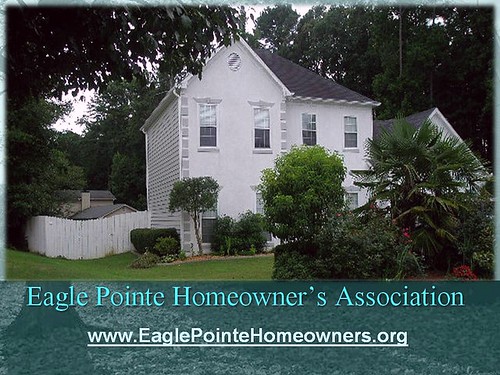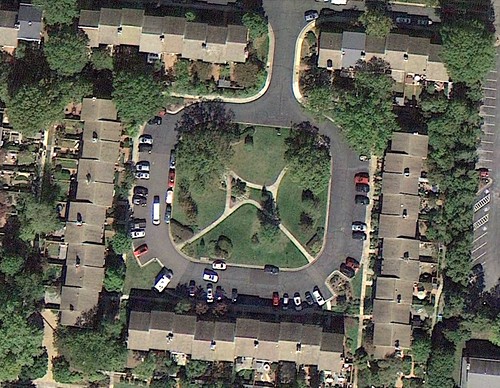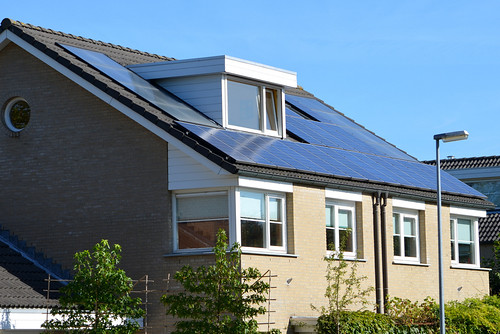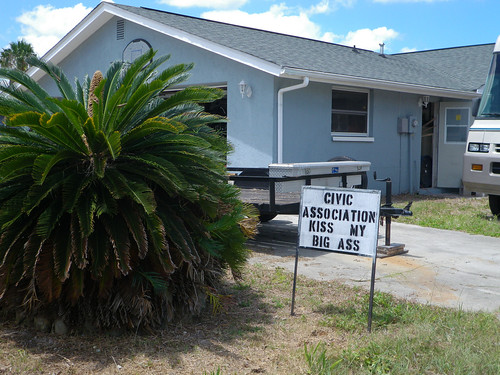Coercion by contract: how homeowners associations stifle expression, sustainability

Posted February 19, 2013 at 1:26PM
In the 1980s, I lived in a small DC condominium complex in the highly walkable Adams-Morgan neighborhood. I was one of 14 unit owners. Another was a fairly well-known Russian writer who had defected; the Cold War was still happening then, if not for much longer. Alex (as I’ll call him) was a great, friendly guy, and really more a fan of American culture than a critic obsessed with Soviet politics.
I was one of the first to buy into the newly rehabbed complex; Alex was in the second group that began to fill the place out. A couple of us tried to recruit him to join the condo board. I’ll always treasure his bemused response: “Hey, I didn’t leave one communist system just to join another.”
There were about 50,000 homeowners associations – including those in multifamily buildings like ours – in the US at the time. Today there are 323,600, presiding over the homes and neighborhoods of an astounding 63.4 million Americans,  according to data published by the Community Associations Institute. Basically, that means in something approaching 20 percent of American homes, you literally cannot live there unless you agree by the terms of your ownership documents to submit to the rules of the governing associations.
according to data published by the Community Associations Institute. Basically, that means in something approaching 20 percent of American homes, you literally cannot live there unless you agree by the terms of your ownership documents to submit to the rules of the governing associations.
I use the word “governing” deliberately, because that is very much what HOAs do (and what my condo board did, when I lived in Adams-Morgan). For example, they have taxing power, setting mandatory dues that if not paid can result in the placement of a lien on your property or even foreclosure; they have regulatory authority, setting rules for everything from when you can take out the trash to what color and materials you use in your window treatments to what you can and cannot grow in your yard. They have enforcement power, too, including the right to issue cease and desist orders and to impose financial penalties in the form of fines. One legal observer has called the exercise of quasi-political powers by HOAs “one of the most significant privatizations of local government functions in history,” pointing out how quickly some of them move to foreclose on private homes because of dues underpayment.
In a lot of places – probably in most – it’s a sort of government-among-friends, where rules are applied and interpreted with good faith and generosity, where neighbors cooperate on upkeep, and where buildings and communities look better and function better because of it. That’s certainly the way it was in the condo where I lived for a decade.
But, in others, homeowners’ associations appear to have more in common with the Soviets than just a communal process. Writing in The Washington Post, Justin Jouvenal recently reported on a knock-down, drag-out fight over a simple political yard sign placed by a couple on their property during the 2008 election season. The association’s grievance, apparently, was that the “Obama for President” placard was four inches taller than the association’s covenants allowed. The scene was a lovely, 44-unit townhouse community set around a pretty green square in Alexandria, Virginia, an inner suburb of DC.
Now, in my book, requiring that the neighbors cut their grass every so often isn’t so unreasonable. But stifling political expression because of a piddly 4-inch, inherently temporary “violation” is. In my lawyering days, I was involved in one and only one case before the US Supreme Court: on behalf of the Justice Department, I wrote and filed a brief siding with three jurisdictions that had banned billboards from within their borders. In deciding a case that began with a lawsuit brought by the billboard companies, the Court practically tied itself in knots trying to come to consensus. The nine Justices wrote or joined in five separate opinions. A plurality of four ruled that the two states and one city involved could ban commercial billboards but not political ones. There was enough agreement among the other opinions that it amounted to a majority ruling on that point.
Now, there are lots of legal distinctions between public statutory law (the billboard case) and restrictions by “voluntary” associations (the neighborhood lawn sign issue). But I still might have advised the homeowners’ association that there could be some risks when it came to rules restricting political expression and that they might want to consider backing off on such a minor, short-term infraction before they got hit with a lawsuit they might lose. In fact, the couple that wanted to display the sign in their yard did sue the association; it took a while, but the couple prevailed and the association lost. And, for good measure, the court ordered the association to recompense the couple for their costs in asserting their legal rights. The association, whose stubbornness had gotten them in way over their heads, ended up having to pay $400,000 (including its own legal fees) and went bankrupt. The lovely green square that has served as the heart of the community is now for sale.
In some cases, HOA rules go directly against individuals who wish to follow green practices. Two years ago, for example, a Florida woman was hit by mounting fines from her HOA simply for gardening. On the web site Food Renegade, writer “KristenM” described the situation:
“Imagine growing a lush, organic garden full of fruit trees and raised beds featuring edible flowers and vegetables. It’s beautiful. And it’s in your backyard. Your slice of heaven. Your respite. The place where you can get your hands dirty growing wholesome, nourishing foods for you and your family.
“One day you stroll out to your mailbox to find a letter from your HOA telling you your garden is in violation of HOA rules. According to your deed restrictions, all fruit trees and edible plants should be grown inside a screened in patio. You face $100/day fines for each day that you refuse to tear up your fruit trees and remove your raised beds.”
Essentially, vegetation was allowed to be planted unless it was grown for food. And this is Florida, where there are fruit trees, in particular, all over the place. I don’t know how that case eventually turned out, but association restrictions on gardening are not unusual.
Another way that HOA rules can get in the way of sustainability is by banning outdoor clothes-drying. The energy savings from the practice can be substantial: electric dryers burn a full 6 percent of our home energy (second among appliances after refrigerators). Many would also argue that the way that people have sun-dried their laundry for millennia also produces, in the right climate, a freshness that hot-air dryers can’t match. The problem, of course, is that once most middle-class homes had acquired indoor electric dryers in the second half of the last century, visible clotheslines became a sign of poverty, something that the kinds of subdivisions that have HOAs want no part of. Most HOA-controlled neighborhoods now ban clotheslines.
Fortunately, concerns about energy consumption and increased environmental awareness have produced a sort of backlash in the form of a “right to dry” movement. As a result, six states – Florida, Colorado, Hawaii, Maine, Maryland, and Vermont – have passed laws rendering these bans void and unenforceable. Jim Howland, who maintains a research project called Making Sustainability Legal, reports that another 13 states have solar access laws that appear to protect solar drying.
Speaking of which, you can imagine what most HOAs not bound by the laws in those 13 states think of solar panels. On the Green blog published by The New York Times, Kate Galbraith detailed several disputes between green-minded homeowners and their associations in a 2009 story. Galbraith added that, for solar installers, the roadblocks can be frustrating: "John Berger, the chief executive of Standard Renewable Energy, a Houston-based firm that designs and installs solar systems for homes, said that the homeowner associations’ prohibitions had already cost him more than $1 million in business." That’s a shame, because there are lots of ways that solar panels can be incorporated into roof design while maintaining a high level of aesthetic appeal.
I’ll discuss one more issue. Consider the matter of non-edible landscaping, which HOAs guard with an iron fist to ensure uniformity. In one example, a Florida homeowner got hit with a lawsuit for planting non-conforming vegetation that did not need irrigation, conserving water. Kevin Spear reported the story four months ago in the Orlando Sentinel:
“A homeowner near Windermere who happens to work for Orange County's environmental department has been sued by her neighborhood association for replacing her thirsty grass with a water-conserving landscape.
“Renee Parker's plants attract butterflies, blossom regularly in multiple colors and have an assortment of shapes and heights. For a meandering border, she planted Argentine bahia, a grass that's hardier than the water-craving, fertilizer-loving St. Augustine variety commonly growing in Florida yards.”
In theory, a 2009 Florida statute prohibits homeowners associations from interfering with residents who pursue “Florida-friendly” landscapes that save water. But Spear’s article says that associations retain their authority “to approve or reject lawn and yard modifications,” and there’s ambiguity in what kinds of plants the law protects.
Meanwhile, in Arizona a homeowner was slapped with fines for planting a native habitat garden featuring Arizona wildflowers. To the HOA, they were just “weeds,” prohibited by the rules. A story posted on the web site of the Windstar Wildlife Institute says that the owner’s landscaping choices were lauded in the magazine Phoenix Home and Garden, which noted that the property “embraces the Sonoran Desert with a landscape rich in indigenous plants.” The Windstar story reports that the case has drawn support from the Tucson Botanical Gardens and the Arizona Native Plant Society. It was unsettled as of the time the story was written.
Do these associations go too far? Do a web search for the phrase “HOA tyranny” and you’ll get an astounding number of results. Among the more extensive is a book-length bill of particulars called The HOA Primer, in which the writer details the horror stories at some length, saying that covenant enforcement “can become an absolute obsession.” AlterNet has a very good story from 2007 (“The Property Cops”), written by Stan Cox, detailing how a variety of HOA and other community rules ban a range of green practices, with examples from across the country.
I suspect – and certainly hope – that it is just a matter of time before HOAs catch up to emerging social values and become more tolerant of new practices to protect ecological values. Maybe the biggest danger will become that the fixation with mandates will remain, but some of those mandates will become pro- rather than anti-environment. That’s certainly better as to substance, but I’m less sure that it would be a great thing as to style.
Meanwhile, The HOA Primer cites real estate agent, consultant and author Joni Greenwalt (Homeowner Associations: A Nightmare or a Dream Come True?), for the point that the best HOA board members actually may be those who are hesitant to serve because they have full lives with work and families, but do so anyway out of a sense of duty. They are less likely to fret about the smaller stuff or have time to go on frequent patrols searching for, say, nonconforming birdhouses.
Taking this thought into account, perhaps my Russian neighbor Alex would have made a great condo board member and we should have recruited him harder. As I recall, he was too busy writing books and having a good time to oppress anybody.
Related posts:
- Residents of award-winning, transit-oriented development say no to transit (February 2, 2011)
- The wonderful world of neighborhood associations: this one will surprise you (February 21, 2011)
- Inch by inch, row by row, gonna make my . . . driveway grow? (August 27, 2009)
- When values collide: balancing green technology and historic buildings (June 25, 2012)
- 'Peace Gardens' bring needy communities together, 'saving our own neighborhood' (August 9, 2010)
Move your cursor over the images for credit information.





